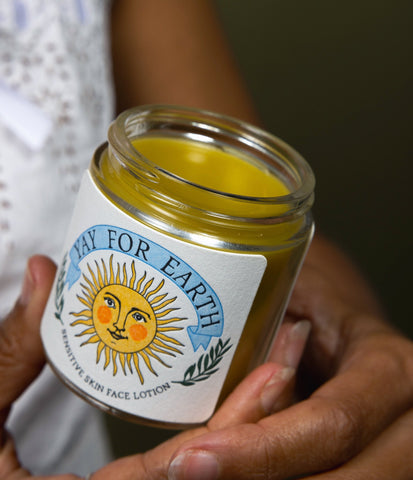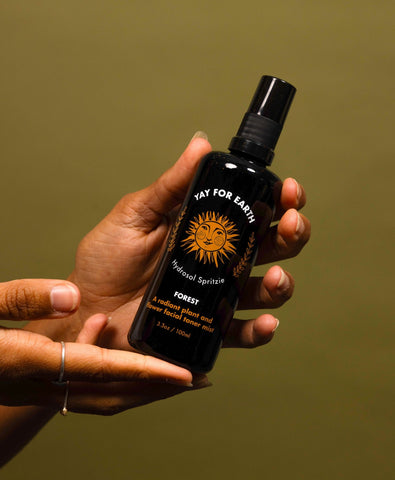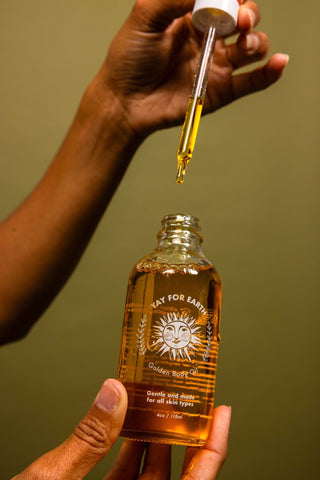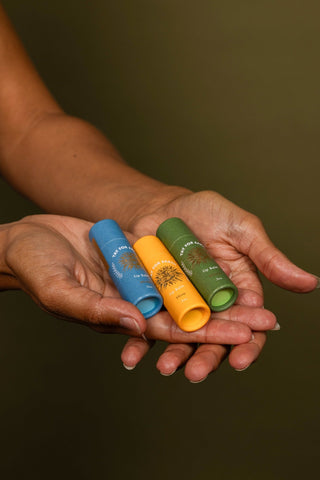You've probably walked past bottles of face sprays a hundred times and assumed they were all basically the same thing—some flowers, some water, maybe a nice smell. But here's what nobody tells you: most of those bottles contain about as much actual plant material as a grocery store tomato contains actual tomato flavor.
Real hydrosols are something entirely different, and the skincare industry's habit of using "hydrosol," "face spray," and "toner" interchangeably has created massive confusion about what you're actually buying. This isn't just semantics—the difference between a true hydrosol and reconstituted flower water is the difference between fresh-squeezed orange juice and orange-flavored drink powder.
If you've ever wondered why some botanical face mists make your skin genuinely happy while others just make it wet, understanding hydrosols will answer that question.
What Exactly is a Hydrosol? (And Why It Matters)
To understand hydrosols, we need to talk about what happens when you steam-distill plant material—a process that's less like cooking and more like capturing a plant's essence in liquid form.
The Distillation Process
Imagine a still: fresh plant material (lavender flowers, rose petals, chamomile blossoms) sits in a chamber while steam passes through it. This steam is hot enough to make the plant cells release their aromatic compounds but gentle enough not to burn or destroy them. As steam moves through the plant matter, it picks up volatile molecules—the aromatic compounds that give plants their distinctive scents and therapeutic properties.
This aromatic steam then travels through a cooling system where it condenses back into liquid. But here's the fascinating part: when this steam cools, it separates naturally into two distinct layers. The top layer is essential oil—concentrated, fat-soluble aromatic compounds. The bottom layer, making up about 99% of what you've distilled, is the hydrosol—water containing water-soluble aromatic compounds, microscopic amounts of essential oil, and dozens of other therapeutic plant constituents.
Why "Co-Product" Changes Everything
Here's the critical distinction that separates true hydrosols from everything else: hydrosols aren't diluted essential oils. They're co-products created simultaneously during the same distillation process, each containing chemically distinct compounds from the same plant.
Essential oils contain fat-loving (lipophilic) molecules. Hydrosols contain water-loving (hydrophilic) molecules. These are different compounds with different molecular weights, different therapeutic properties, and different ways of interacting with your skin. You literally cannot replicate a hydrosol by adding essential oil to water because the therapeutic compounds in a true hydrosol don't exist in the essential oil at all.
This concept of complementary components working together forms the foundation of truly effective natural skincare. Just as hydrosols and essential oils are both valuable but serve different purposes, the best skincare routines combine water-based and oil-based products that complement rather than compete.
The Molecular Advantage
The molecules in hydrosols are smaller and lighter than those concentrated in essential oils, allowing them to penetrate the skin barrier easily without causing sensitivity. Even people who can't tolerate essential oils on their skin often find hydrosols perfectly gentle.
Most hydrosols naturally land in a pH range of 4.0-6.5, aligning beautifully with your skin's natural pH of around 5.5. The organic acids and other compounds that dissolve into the water during distillation create this naturally compatible pH without any adjustment needed. This matters because your skin maintains a slightly acidic "acid mantle" as your first line of defense. Conventional toners with wrong pH levels disrupt this barrier; hydrosols support it.
The Science Behind Why Hydrosols Actually Work
Water-Soluble Therapeutic Compounds
During steam distillation, oil-soluble molecules concentrate in the essential oil layer, while water-soluble molecules remain in the hydrosol. These include organic acids, hydrophilic antioxidants, flavonoids, tannins, and various therapeutic molecules that integrate seamlessly into your skin barrier because they're already dissolved in water—the same medium that makes up about 60% of your skin.
Your skin's outer layers are primarily aqueous environments. Water-soluble compounds move through these layers efficiently, delivering benefits exactly where needed. Fat-soluble compounds (like those in oils) serve different purposes, working primarily on barrier protection. Both are valuable; they're just doing different jobs.
Concentration Isn't Everything
Hydrosols contain roughly 0.02-0.2% aromatic compounds compared to pure essential oils, yet this dilution makes them appropriately gentle rather than weak. The therapeutic compounds work through consistent support of your skin's natural processes rather than aggressive intervention.
Think of it like nutrition: you don't need pure vitamin C powder to benefit from vitamin C. The vitamin C in a blueberry, delivered alongside fiber and antioxidants, often works better than isolated synthetic vitamins. Hydrosols deliver therapeutic compounds in a context your skin can readily use.
Selective Antimicrobial Action
Your skin hosts trillions of microorganisms forming your skin microbiome—a complex ecosystem crucial for protection, inflammation control, and overall skin health. Harsh antiseptic toners indiscriminately kill all microorganisms, creating disruption that can worsen skin problems by eliminating beneficial species.
Hydrosols have selective antimicrobial effects—research suggests they help keep problematic bacteria in check while minimizing impact on beneficial species. This selective action supports a balanced microbiome rather than scorched-earth destruction.
Anti-Inflammatory and Antioxidant Benefits
Many hydrosols contain water-soluble anti-inflammatory compounds that modulate inflammatory responses at the cellular level. Chamomile hydrosol contains water-soluble flavonoids that inhibit inflammatory pathways. Rose hydrosol provides phenolic compounds with both antioxidant and anti-inflammatory properties.
The water-soluble antioxidants in hydrosols—including phenolic acids and polyphenols—neutralize free radicals that contribute to premature aging and inflammation. These work in the aqueous layers of your skin, complementing fat-soluble antioxidants that work in lipid-rich areas.
Supporting Barrier Function Without Disruption
One of the most valuable properties of quality hydrosols is what they don't do. They don't strip your skin. They don't disrupt your acid mantle. They don't introduce harsh preservatives or unnecessary additives. They support your skin's existing protective mechanisms while providing therapeutic benefits.
Your skin barrier is remarkably intelligent. When you support it properly—maintaining the right pH, providing appropriate hydration, delivering beneficial compounds without disruption—it does its job extraordinarily well. Hydrosols work with this intelligence rather than against it.

Popular Hydrosols and Their Specific Benefits
Rose Hydrosol: The Universal Gentle Giant
Rose hydrosol suits nearly every skin type, offering mild astringent properties that tone without drying, anti-inflammatory effects that calm redness, and gentle antimicrobial action. The phenolic compounds provide antioxidant protection while supporting microcirculation. Particularly valuable for mature, sensitive, and combination skin.
Lavender Hydrosol: The Calming All-Rounder
Lavender hydrosol provides anti-inflammatory support for sensitive skin, helps regulate oil production for breakout-prone skin, and offers gentle antimicrobial properties. Ideal for stressed skin, minor irritations, and as a complement to healing treatments.
Chamomile Hydrosol: The Sensitivity Specialist
Chamomile hydrosol excels for reactive, sensitive skin types with powerful anti-inflammatory compounds including bisabolol and chamazulene derivatives. These can significantly reduce inflammatory responses causing redness and irritation. Perfect for eczema-prone skin, skin recovering from treatments, and reactive skin that flares easily.
Neroli Hydrosol: The Regenerative Wonder
Neroli (orange blossom) hydrosol contains compounds that support skin regeneration and cellular renewal, including specific flavonoids that promote cell turnover. Works beautifully for mature skin showing signs of aging, scarred or damaged skin, and dull skin requiring brightness restoration.
SHOP YAY FOR EARTH'S HYDROSOL SPRITZIE
How to Use Hydrosols Effectively
Basic Application Methods
Spray Application: Spritz onto clean skin from 6-8 inches away for even, light coverage. Perfect for refreshing throughout the day, setting makeup, or providing quick hydration.
Cotton Pad Application: Saturate a cotton pad and gently sweep across your face in upward motions. This provides more toning action and helps remove last traces of cleanser.
Compress Application: For irritated areas, soak a soft cloth in hydrosol and apply as a gentle compress for 5-10 minutes. Particularly effective for sunburn, redness, or reactive flare-ups.
Integration into Your Routine
Morning: After cleansing, apply hydrosol to balance pH and prepare skin. Follow with moisturizer and SPF.
Evening: Cleanse, apply hydrosol to restore balance, then apply treatment products or night cream. Evening is when your skin does intensive repair work.
Throughout the Day: Keep a small spray bottle for refreshing misting whenever needed—after gym sessions, during dry office hours, or for midday boosts.

What Makes a Quality Hydrosol
Production Method Matters
True hydrosols must be produced through steam distillation of plant material. Without proper distillation, you don't have a hydrosol regardless of label claims.
Avoid products that are actually:
Distillate waters: Essential oils added back into water
"Nature-identical" fragrances: Synthetic compounds in water
Botanical extracts: Plants soaked in water (infusions, not hydrosols)
True hydrosols specify "steam-distilled" from specific plant material. Reputable producers are transparent about distillation methods.
Organic Certification and Source Quality
Organic certification matters significantly. Organic plants are grown without synthetic pesticides that could concentrate in the distillate. Beyond avoiding chemicals, organic farming often results in plants with higher concentrations of beneficial compounds.
When evaluating skincare brands, look for companies that prioritize organic sourcing across all products.
At Yay for Earth, we exemplify this commitment—working only with trusted organic farmers, ensuring every ingredient meets rigorous standards. This isn't just about avoiding chemicals; it's about supporting regenerative farming practices that create more nutrient-dense ingredients.
Small-batch production often correlates with higher quality because each batch receives individual attention. When producers carefully monitor distillation, test each batch, and maintain rigorous standards, you get fresher, more potent products.
Storage and Preservation
Quality hydrosols should be stored in dark glass bottles to protect from light degradation. Some producers add minimal natural preservatives like leucidal (derived from radishes) to extend shelf life safely.
Hydrosols typically maintain optimal quality for 12-24 months when stored properly in cool, dark conditions. Once opened, refrigeration can extend freshness. Signs of degradation include cloudiness, off-smells, or visible growth.
Source Transparency
Reputable producers provide clear information about specific plant species, geographic origin, distillation dates, organic certification, and storage recommendations. Be wary of brands that won't share this information.
SHOP YAY FOR EARTH'S HYDROSOL SPRITZIE
Hydrosols vs. Other Toning Options
Understanding how hydrosols compare to other products marketed for similar purposes clarifies why quality distinctions matter so much.
Alcohol-Based Toners: Conventional toners often contain high alcohol concentrations (20-60%) that strip skin and disrupt both the acid mantle and microbiome. While they create immediate tightness that feels like "deep cleaning," this sensation indicates barrier damage. The disruption often triggers increased oil production as your skin desperately tries to restore protection—creating a cycle where the product promising to control oil actually worsens the problem.
Witch Hazel (Commercial): While witch hazel has legitimate astringent properties, most commercial versions contain significant alcohol (14-15%) and lack the therapeutic diversity of true hydrosols. The alcohol negates many benefits. If you love witch hazel, seek true distilled witch hazel hydrosol without added alcohol.
Micellar Waters: Micellar waters can be effective cleansing products, but they serve a different function than hydrosols. They're designed to remove makeup and cleanse, not to provide therapeutic benefits or pH balancing. Using both makes perfect sense—micellar water for cleansing, hydrosol for toning.

Pairing Hydrosols with Natural Moisturizers
Hydrosols work beautifully as part of thoughtful natural skincare, but they're not meant to work alone. Understanding the complementary roles of water-based and oil-based products transforms your approach.
Why Both Matter
Hydrosols deliver: Water-soluble therapeutic compounds, pH balancing, light hydration, antimicrobial support, and preparation for better absorption.
Oil-based moisturizers provide: Fat-soluble nutrients, essential fatty acids, barrier protection, moisture sealing, and different classes of antioxidants.
When layered properly, each product enhances the other's effectiveness. The hydrosol prepares skin to receive maximum benefits from moisturizer. The moisturizer seals in everything the hydrosol delivered while providing its own array of benefits.
The Science of Layering
When you apply hydrosol to freshly cleansed skin: pH restoration occurs, hydration reaches aqueous layers, therapeutic compounds absorb directly, and your skin barrier becomes balanced and primed.
Now when you apply quality oil-based moisturizer, your skin is prepared perfectly. The moisturizer provides fat-soluble nutrition, barrier reinforcement, moisture sealing, and anti-inflammatory support that complements water-soluble benefits.
This isn't complicated layering of seven products. It's two complementary products—one water-based, one oil-based—each doing what it does best.
The Minimalist Approach
Consider pairing a quality hydrosol with a minimal sensitive skin face lotion. Together, these address every aspect of skin health: hydration, barrier function, inflammation control, oxidative stress protection, and balanced support.
This approach consistently produces better results than multi-step routines with redundant products. Skin becomes more balanced, less reactive, and genuinely healthier because you're supporting natural processes with exactly what they need.
SHOP YAY FOR EARTH'S SENSITIVE SKIN FACE LOTION

Building Your Complete Routine
The Morning Ritual
Step 1: Gentle Cleanse - Start with lukewarm water and a gentle cleanser if needed. Many people find morning cleansing with just water works beautifully.
Step 2: Hydrosol Application - Spritz chosen hydrosol onto clean, slightly damp skin. Give it 30-60 seconds to absorb.
Step 3: Moisturizer - Apply oil-based moisturizer while skin is slightly damp from hydrosol. You'll need less product when applied to hydrosol-prepped skin.
Step 4: SPF - Follow with mineral-based sunscreen if spending time outdoors.
The Evening Restoration
Step 1: Thorough Cleansing - Remove the day's accumulation—pollutants, sunscreen, oils, makeup.
Step 2: Hydrosol Treatment - Be generous. After cleansing, skin needs pH balancing and hydration for repair work.
Step 3: Moisturizer - Evening application can be slightly more generous, as this is when skin does intensive repair.
Why This Works
This three-product approach addresses every aspect of healthy skin. Cleansing removes impurities without stripping. Hydrosol restores balance and delivers water-soluble therapeutics. Moisturizer provides oil-soluble nutrition, anti-inflammatory support, antioxidant protection, and barrier reinforcement.
You're not missing anything by keeping it simple. You're giving skin exactly what it needs without ingredient conflicts or pH disruptions.
SHOP YAY FOR EARTH'S ORGANIC SKINCARE
The Long-Term Benefits Approach
Natural skincare works through consistent, gentle support rather than dramatic intervention. A quality hydrosol used daily for months provides cumulative benefits:
Gradually improved barrier function
Better microbial balance
Reduced overall reactivity
More resilient, adaptable skin
Similarly, using high-quality moisturizers consistently—rather than switching products constantly—allows skin to fully benefit over time. This is why many find that sticking with simple formulations produces better long-term results than chasing trendy ingredients.
When you commit to quality over novelty, your skin rewards that consistency with genuine health rather than temporary improvements.
Common Misconceptions About Hydrosols
"They're just fancy water": True hydrosols contain hundreds of therapeutic compounds that plain water doesn't have. The distillation process extracts and preserves specific plant constituents.
"More expensive means better": Price doesn't always indicate quality. Focus on production methods and ingredient sourcing rather than price alone.
"They replace moisturizer": Hydrosols provide hydration but not barrier protection. You still need moisturizer to seal in benefits.
"All face sprays are basically the same": The difference between true hydrosol and fragrance-scented water is profound. One contains actual therapeutic compounds from steam distillation; the other is often just fragrance in water.
Frequently Asked Questions
Can I create my own hydrosol by mixing essential oil with water?
No—mixing essential oil with water creates a suspension, not a hydrosol. True hydrosols contain water-soluble compounds extracted during steam distillation that aren't present in essential oils.
How do hydrosols compare to traditional toners?
Hydrosols provide everything a good toner should—pH balancing, light hydration, preparation for subsequent products—plus therapeutic benefits like anti-inflammatory compounds and antioxidants that conventional toners lack.
Are hydrosols safe during pregnancy?
Most hydrosols are exceptionally gentle and generally safe during pregnancy. Commonly used hydrosols like rose, chamomile, and lavender are typically fine, but always consult your healthcare provider.
How long does a bottle last?
A 4-ounce bottle typically lasts 1-3 months with daily use. The relatively short shelf life means it's often better to buy smaller bottles more frequently.
Do I still need a moisturizer?
Yes! Hydrosols provide hydration but don't create a protective barrier. Following hydrosol with a quality moisturizer seals in benefits while providing additional nourishment. This is why pairing a hydrosol with something like Yay for Earth's Sensitive Skin Face Lotion creates such remarkable results—the hydrosol delivers water-soluble benefits, and the lotion provides oil-soluble nutrition plus barrier protection.
Can the same hydrosol work for different skin types?
Yes. Because hydrosols work by supporting your skin's natural processes rather than forcing specific effects, the same hydrosol often works well across different skin types. Rose hydrosol, for instance, provides benefits for dry, oily, combination, and sensitive skin.
The Philosophy: Working With Your Skin's Wisdom
Understanding hydrosols teaches a larger lesson about skincare: your skin possesses remarkable intelligence. When you support its natural processes with appropriate, high-quality ingredients—rather than forcing effects through harsh intervention—it flourishes.
This philosophy extends beyond hydrosols to your entire approach. Whether choosing a hydrosol, selecting a moisturizer, or deciding on any skincare product, ask: does this work with my skin's natural wisdom, or against it?
Products that work with your skin support rather than suppress natural processes, provide nutrients your skin can use, maintain optimal pH, respect your microbiome, and strengthen your barrier. The skincare industry often promotes complexity and dramatic transformation, but the most profound results come from simplicity, quality, and patient consistency.
Disclaimer
The information provided in this article is for educational and informational purposes only and is not intended as medical advice, diagnosis, or treatment. While hydrosols are generally very gentle and well-tolerated by most people, individual skin responses can vary significantly based on skin type, sensitivities, existing conditions, and numerous other factors.
Always perform patch tests before applying new skincare products to your face, especially if you have a history of skin sensitivities, allergies, or reactive skin. If you experience any irritation, redness, itching, or adverse reactions, discontinue use immediately.
If you have specific skin conditions such as severe acne, rosacea, eczema, psoriasis, or other dermatological concerns, consult with a dermatologist before making significant changes to your skincare routine. Pregnant or breastfeeding individuals should consult with their healthcare providers before using new skincare products, including hydrosols.
This article does not replace consultation with qualified skincare professionals. Individual results from hydrosol use will vary based on product quality, application methods, skin type, environmental factors, and numerous other variables.





